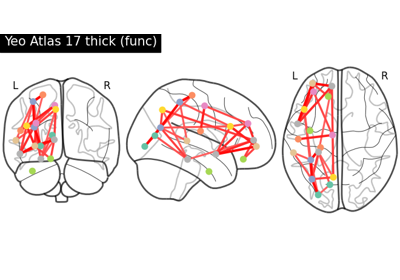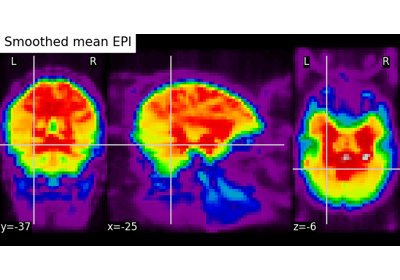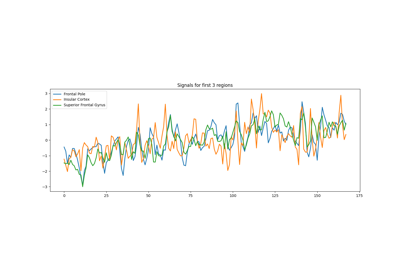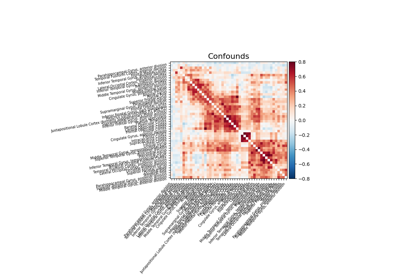Note
This page is a reference documentation. It only explains the class signature, and not how to use it. Please refer to the user guide for the big picture.
nilearn.maskers.NiftiLabelsMasker¶
- class nilearn.maskers.NiftiLabelsMasker(labels_img=None, labels=None, lut=None, background_label=0, mask_img=None, smoothing_fwhm=None, standardize=False, standardize_confounds=True, high_variance_confounds=False, detrend=False, low_pass=None, high_pass=None, t_r=None, dtype=None, resampling_target='data', memory=None, memory_level=1, verbose=0, strategy='mean', keep_masked_labels=False, reports=True, cmap='CMRmap_r', clean_args=None)[source]¶
Class for extracting data from Niimg-like objects using labels of non-overlapping brain regions.
NiftiLabelsMasker is useful when data from non-overlapping volumes should be extracted (contrarily to
nilearn.maskers.NiftiMapsMasker).Use case: summarize brain signals from clusters that were obtained by prior K-means or Ward clustering.
For more details on the definitions of labels in Nilearn, see the Extraction of signals from regions: NiftiLabelsMasker, NiftiMapsMasker section.
- Parameters:
- labels_imgNiimg-like object or None, default=None
See Input and output: neuroimaging data representation. Region definitions, as one image of labels.
- labels
listofstr, optional Full labels corresponding to the labels image. This is used to improve reporting quality if provided. Mutually exclusive with
lut.“Background” can be included in this list of labels to denote which values in the image should be considered background value.
Warning
The labels must be consistent with the label values provided through
labels_img. If too many labels are passed, a warning is thrown and extra labels are dropped. If too few labels are passed, extra regions will get the ‘unknown’ label.- lut
pandas.DataFrameorstrorpathlib.Pathto a TSV file or None, default=None Mutually exclusive with
labels. Act as a look up table (lut) with at least columns ‘index’ and ‘name’. Formatted according to ‘dseg.tsv’ format from BIDS.Warning
If a region exist in the atlas image but is missing from its associated LUT, a new entry will be added to the LUT during fit with the name “unknown”. Conversely, if regions listed in the LUT do not exist in the associated atlas image, they will be dropped from the LUT during fit.
- background_label
intorfloat, default=0 Label used in labels_img to represent background.
- mask_imgNiimg-like object, optional
See Input and output: neuroimaging data representation. Mask to apply to regions before extracting signals.
- smoothing_fwhm
floatorintor None, optional. If smoothing_fwhm is not None, it gives the full-width at half maximum in millimeters of the spatial smoothing to apply to the signal.
- standardizeany of: ‘zscore_sample’, ‘zscore’, ‘psc’, True, False or None; default=False
Strategy to standardize the signal:
'zscore_sample': The signal is z-scored. Timeseries are shifted to zero mean and scaled to unit variance. Uses sample std.'zscore': The signal is z-scored. Timeseries are shifted to zero mean and scaled to unit variance. Uses population std by calling defaultnumpy.stdwith N -ddof=0.Deprecated since Nilearn 0.10.1: This option will be removed in Nilearn version 0.14.0. Use
zscore_sampleinstead.'psc': Timeseries are shifted to zero mean value and scaled to percent signal change (as compared to original mean signal).True: The signal is z-scored (same as option zscore). Timeseries are shifted to zero mean and scaled to unit variance.Deprecated since Nilearn 0.13.0: In nilearn version 0.15.0,
Truewill be replaced by'zscore_sample'.False: Do not standardize the data.Deprecated since Nilearn 0.13.0: In nilearn version 0.15.0,
Falsewill be replaced byNone.
Deprecated since Nilearn 0.15.0dev: The default will be changed to
Nonein version 0.15.0.- standardize_confounds
bool, default=True If set to True, the confounds are z-scored: their mean is put to 0 and their variance to 1 in the time dimension.
- high_variance_confounds
bool, default=False If True, high variance confounds are computed on provided image with
nilearn.image.high_variance_confoundsand default parameters and regressed out.- detrend
bool, optional Whether to detrend signals or not.
- low_pass
floatorintor None, default=None Low cutoff frequency in Hertz. If specified, signals above this frequency will be filtered out. If None, no low-pass filtering will be performed.
- high_pass
floatorintor None, default=None High cutoff frequency in Hertz. If specified, signals below this frequency will be filtered out.
- t_r
floatorintor None, default=None Repetition time, in seconds (sampling period). Set to None if not provided.
- dtypedtype like, “auto” or None, default=None
Data type toward which the data should be converted. If “auto”, the data will be converted to int32 if dtype is discrete and float32 if it is continuous. If None, data will not be converted to a new data type.
- resampling_target{“data”, “labels”, None}, default=”data”
Defines which image gives the final shape/size.
"data"means the atlas is resampled to the shape of the data if needed."labels"means that themask_imgand images provided tofit()are resampled to the shape and affine oflabels_img."None"means no resampling: if shapes and affines do not match, aValueErroris raised.
- memoryNone, instance of
joblib.Memory,str, orpathlib.Path, default=None Used to cache the masking process. By default, no caching is done. If a
stris given, it is the path to the caching directory.- memory_level
int, default=1 Rough estimator of the amount of memory used by caching. Higher value means more memory for caching. Zero means no caching.
- verbose
boolorint, default=0 Verbosity level (
0orFalsemeans no message).- strategy
str, default=”mean” The name of a valid function to reduce the region with. Must be one of: sum, mean, median, minimum, maximum, variance, standard_deviation.
- keep_masked_labels
bool, default=False When a mask is supplied through the “mask_img” parameter, some atlas regions may lie entirely outside of the brain mask, resulting in empty time series for those regions. If True, the masked atlas with these empty labels will be retained in the output, resulting in corresponding time series containing zeros only. If False, the empty labels will be removed from the output, ensuring no empty time series are present.
Deprecated since Nilearn 0.10.2.
Changed in Nilearn 0.13.0: The
keep_masked_labelsparameter will be removed in 0.15.- reports
bool, default=True If set to True, data is saved in order to produce a report.
- cmap
matplotlib.colors.Colormap, orstr, optional The colormap to use. Either a string which is a name of a matplotlib colormap, or a matplotlib colormap object. default=”CMRmap_r” Only relevant for the report figures.
- clean_args
dictor None, default=None Keyword arguments to be passed to
cleancalled within the masker. Withinclean, kwargs prefixed with'butterworth__'will be passed to the Butterworth filter.Added in Nilearn 0.12.0.
- Attributes:
- clean_args_
dict Keyword arguments to be passed to
cleancalled within the masker. Withinclean, kwargs prefixed with'butterworth__'will be passed to the Butterworth filter.- labels_img_
nibabel.nifti1.Nifti1Image The labels image.
- lut_
pandas.DataFrame Look-up table derived from the
labelsorlutor from the values of the label image.- mask_img_A 3D binary
nibabel.nifti1.Nifti1Imageor None. The mask of the data. If no
mask_imgwas passed at masker construction, thenmask_img_isNone, otherwise is the resulting binarized version ofmask_imgwhere each voxel isTrueif all values across samples (for example across timepoints) is finite value different from 0.- memory_joblib memory cache
- clean_args_
See also
- __init__(labels_img=None, labels=None, lut=None, background_label=0, mask_img=None, smoothing_fwhm=None, standardize=False, standardize_confounds=True, high_variance_confounds=False, detrend=False, low_pass=None, high_pass=None, t_r=None, dtype=None, resampling_target='data', memory=None, memory_level=1, verbose=0, strategy='mean', keep_masked_labels=False, reports=True, cmap='CMRmap_r', clean_args=None)[source]¶
- background_label¶
- fit(imgs=None, y=None)[source]¶
Prepare signal extraction from regions.
- Parameters:
- imgs
listof Niimg-like objects or None, default=None See Input and output: neuroimaging data representation. Image data passed to the reporter.
- yNone
This parameter is unused. It is solely included for scikit-learn compatibility.
- imgs
- fit_transform(imgs, y=None, confounds=None, sample_mask=None)[source]¶
Prepare and perform signal extraction from regions.
- Parameters:
- imgs3D/4D Niimg-like object
See Input and output: neuroimaging data representation. Images to process. If a 3D niimg is provided, a 1D array is returned.
- yNone
This parameter is unused. It is solely included for scikit-learn compatibility.
- region_ids_: dict[str | int, int | float] = {}
- if self.background_label in index:
index.pop(index.index(self.background_label)) region_ids_[“background”] = self.background_label
- for i, id in enumerate(index):
region_ids_[i] = id # noqa : PERF403
- return region_ids_
- confounds
numpy.ndarray,str,pathlib.Path,pandas.DataFrameorlistof confounds timeseries, default=None This parameter is passed to
nilearn.signal.clean. Please see the related documentation for details. shape: (number of scans, number of confounds)- sample_maskAny type compatible with numpy-array indexing, default=None
shape = (total number of scans - number of scans removed)for explicit index (for example,sample_mask=np.asarray([1, 2, 4])), orshape = (number of scans)for binary mask (for example,sample_mask=np.asarray([False, True, True, False, True])). Masks the images along the last dimension to perform scrubbing: for example to remove volumes with high motion and/or non-steady-state volumes. This parameter is passed tonilearn.signal.clean.Added in Nilearn 0.8.0.
- Returns:
- signals
numpy.ndarray,pandas.DataFrameor polars.DataFrame Signal for each element.
Changed in Nilearn 0.13.0: Added
set_outputsupport.The type of the output is determined by
set_output(): see the scikit-learn documentation.Output shape for :
For Numpy outputs:
3D images: (number of elements,)
4D images: (number of scans, number of elements) array
For DataFrame outputs:
3D or 4D images: (number of scans, number of elements) array
- signals
- generate_report(title=None)[source]¶
Generate an HTML report for the current object.
- Parameters:
- title
stror None, default=None title for the report. If None, title will be the class name.
- title
- Returns:
- reportnilearn.reporting.html_report.HTMLReport
HTML report for the masker.
- get_feature_names_out(input_features=None)[source]¶
Get output feature names for transformation.
- Parameters:
- input_features :default=None
Only for sklearn API compatibility.
- get_metadata_routing()¶
Get metadata routing of this object.
Please check User Guide on how the routing mechanism works.
- Returns:
- routingMetadataRequest
A
MetadataRequestencapsulating routing information.
- get_params(deep=True)¶
Get parameters for this estimator.
- Parameters:
- deepbool, default=True
If True, will return the parameters for this estimator and contained subobjects that are estimators.
- Returns:
- paramsdict
Parameter names mapped to their values.
- inverse_transform(signals)[source]¶
Compute voxel signals from region signals.
Any mask given at initialization is taken into account.
Changed in Nilearn 0.9.2: This method now supports 1D arrays, which will produce 3D images.
- Parameters:
- signals1D/2D
numpy.ndarray Extracted signal. If a 1D array is provided, then the shape should be (number of elements,). If a 2D array is provided, then the shape should be (number of scans, number of elements).
- signals1D/2D
- Returns:
- img
nibabel.nifti1.Nifti1Image Transformed image in brain space. Output shape for :
1D array : 3D
nibabel.nifti1.Nifti1Imagewill be returned.2D array : 4D
nibabel.nifti1.Nifti1Imagewill be returned.
- img
- property labels_¶
Return list of labels of the regions.
The background label is included if present in the image.
- lut_¶
- property n_elements_¶
Return number of regions.
This is equal to the number of unique values in the fitted label image, minus the background value.
- property region_ids_¶
Return dictionary containing the region ids corresponding to each column in the array returned by transform.
The region id corresponding to
region_signal[:,i]isregion_ids_[i].region_ids_['background']is the background label.
- property region_names_¶
Return a dictionary containing the region names corresponding to each column in the array returned by transform.
The region names correspond to the labels provided in labels in input. The region name corresponding to
region_signal[:,i]isregion_names_[i].
- set_fit_request(*, imgs='$UNCHANGED$')¶
Configure whether metadata should be requested to be passed to the
fitmethod.Note that this method is only relevant when this estimator is used as a sub-estimator within a meta-estimator and metadata routing is enabled with
enable_metadata_routing=True(seesklearn.set_config). Please check the User Guide on how the routing mechanism works.The options for each parameter are:
True: metadata is requested, and passed tofitif provided. The request is ignored if metadata is not provided.False: metadata is not requested and the meta-estimator will not pass it tofit.None: metadata is not requested, and the meta-estimator will raise an error if the user provides it.str: metadata should be passed to the meta-estimator with this given alias instead of the original name.
The default (
sklearn.utils.metadata_routing.UNCHANGED) retains the existing request. This allows you to change the request for some parameters and not others.Added in version 1.3.
- Parameters:
- imgsstr, True, False, or None, default=sklearn.utils.metadata_routing.UNCHANGED
Metadata routing for
imgsparameter infit.
- Returns:
- selfobject
The updated object.
- set_inverse_transform_request(*, signals='$UNCHANGED$')¶
Configure whether metadata should be requested to be passed to the
inverse_transformmethod.Note that this method is only relevant when this estimator is used as a sub-estimator within a meta-estimator and metadata routing is enabled with
enable_metadata_routing=True(seesklearn.set_config). Please check the User Guide on how the routing mechanism works.The options for each parameter are:
True: metadata is requested, and passed toinverse_transformif provided. The request is ignored if metadata is not provided.False: metadata is not requested and the meta-estimator will not pass it toinverse_transform.None: metadata is not requested, and the meta-estimator will raise an error if the user provides it.str: metadata should be passed to the meta-estimator with this given alias instead of the original name.
The default (
sklearn.utils.metadata_routing.UNCHANGED) retains the existing request. This allows you to change the request for some parameters and not others.Added in version 1.3.
- Parameters:
- signalsstr, True, False, or None, default=sklearn.utils.metadata_routing.UNCHANGED
Metadata routing for
signalsparameter ininverse_transform.
- Returns:
- selfobject
The updated object.
- set_output(*, transform=None)¶
Set output container.
See Introducing the set_output API for an example on how to use the API.
- Parameters:
- transform{“default”, “pandas”, “polars”}, default=None
Configure output of transform and fit_transform.
“default”: Default output format of a transformer
“pandas”: DataFrame output
“polars”: Polars output
None: Transform configuration is unchanged
Added in version 1.4: “polars” option was added.
- Returns:
- selfestimator instance
Estimator instance.
- set_params(**params)¶
Set the parameters of this estimator.
The method works on simple estimators as well as on nested objects (such as
Pipeline). The latter have parameters of the form<component>__<parameter>so that it’s possible to update each component of a nested object.- Parameters:
- **paramsdict
Estimator parameters.
- Returns:
- selfestimator instance
Estimator instance.
- set_transform_request(*, confounds='$UNCHANGED$', imgs='$UNCHANGED$', sample_mask='$UNCHANGED$')¶
Configure whether metadata should be requested to be passed to the
transformmethod.Note that this method is only relevant when this estimator is used as a sub-estimator within a meta-estimator and metadata routing is enabled with
enable_metadata_routing=True(seesklearn.set_config). Please check the User Guide on how the routing mechanism works.The options for each parameter are:
True: metadata is requested, and passed totransformif provided. The request is ignored if metadata is not provided.False: metadata is not requested and the meta-estimator will not pass it totransform.None: metadata is not requested, and the meta-estimator will raise an error if the user provides it.str: metadata should be passed to the meta-estimator with this given alias instead of the original name.
The default (
sklearn.utils.metadata_routing.UNCHANGED) retains the existing request. This allows you to change the request for some parameters and not others.Added in version 1.3.
- Parameters:
- confoundsstr, True, False, or None, default=sklearn.utils.metadata_routing.UNCHANGED
Metadata routing for
confoundsparameter intransform.- imgsstr, True, False, or None, default=sklearn.utils.metadata_routing.UNCHANGED
Metadata routing for
imgsparameter intransform.- sample_maskstr, True, False, or None, default=sklearn.utils.metadata_routing.UNCHANGED
Metadata routing for
sample_maskparameter intransform.
- Returns:
- selfobject
The updated object.
- transform(imgs, confounds=None, sample_mask=None)[source]¶
Apply mask, spatial and temporal preprocessing.
- Parameters:
- imgs3D/4D Niimg-like object
See Input and output: neuroimaging data representation. Images to process. If a 3D niimg is provided, a 1D array is returned.
- confounds
numpy.ndarray,str,pathlib.Path,pandas.DataFrameorlistof confounds timeseries, default=None This parameter is passed to
nilearn.signal.clean. Please see the related documentation for details. shape: (number of scans, number of confounds)- sample_maskAny type compatible with numpy-array indexing, default=None
shape = (total number of scans - number of scans removed)for explicit index (for example,sample_mask=np.asarray([1, 2, 4])), orshape = (number of scans)for binary mask (for example,sample_mask=np.asarray([False, True, True, False, True])). Masks the images along the last dimension to perform scrubbing: for example to remove volumes with high motion and/or non-steady-state volumes. This parameter is passed tonilearn.signal.clean.Added in Nilearn 0.8.0.
- Returns:
- signals
numpy.ndarray,pandas.DataFrameor polars.DataFrame Signal for each element.
Changed in Nilearn 0.13.0: Added
set_outputsupport.The type of the output is determined by
set_output(): see the scikit-learn documentation.Output shape for :
For Numpy outputs:
3D images: (number of elements,)
4D images: (number of scans, number of elements) array
For DataFrame outputs:
3D or 4D images: (number of scans, number of elements) array
- signals
- transform_single_imgs(imgs, confounds=None, sample_mask=None)[source]¶
Extract signals from a single 4D niimg.
- Parameters:
- imgs3D/4D Niimg-like object
See Input and output: neuroimaging data representation. Images to process.
- confounds
numpy.ndarray,str,pathlib.Path,pandas.DataFrameorlistof confounds timeseries, default=None This parameter is passed to
nilearn.signal.clean. Please see the related documentation for details. shape: (number of scans, number of confounds)- sample_maskAny type compatible with numpy-array indexing, default=None
shape = (total number of scans - number of scans removed)for explicit index (for example,sample_mask=np.asarray([1, 2, 4])), orshape = (number of scans)for binary mask (for example,sample_mask=np.asarray([False, True, True, False, True])). Masks the images along the last dimension to perform scrubbing: for example to remove volumes with high motion and/or non-steady-state volumes. This parameter is passed tonilearn.signal.clean.Added in Nilearn 0.8.0.
- Attributes:
- region_atlas_Niimg-like object
Regions definition as labels. The labels correspond to the indices in
region_ids_. The region inregion_atlas_that takes the valueregion_ids_[i]is used to compute the signal inregion_signal[:, i].Added in Nilearn 0.10.3.
- Returns:
- signals
numpy.ndarray,pandas.DataFrameor polars.DataFrame Signal for each element.
Changed in Nilearn 0.13.0: Added
set_outputsupport.The type of the output is determined by
set_output(): see the scikit-learn documentation.Output shape for :
For Numpy outputs:
3D images: (number of elements,)
4D images: (number of scans, number of elements) array
For DataFrame outputs:
3D or 4D images: (number of scans, number of elements) array
- signals
Examples using nilearn.maskers.NiftiLabelsMasker¶

Comparing connectomes on different reference atlases

Computing a Region of Interest (ROI) mask manually

Extracting signals from brain regions using the NiftiLabelsMasker
